Success Stories from Leading Omnichannel Solution Providers in Retail
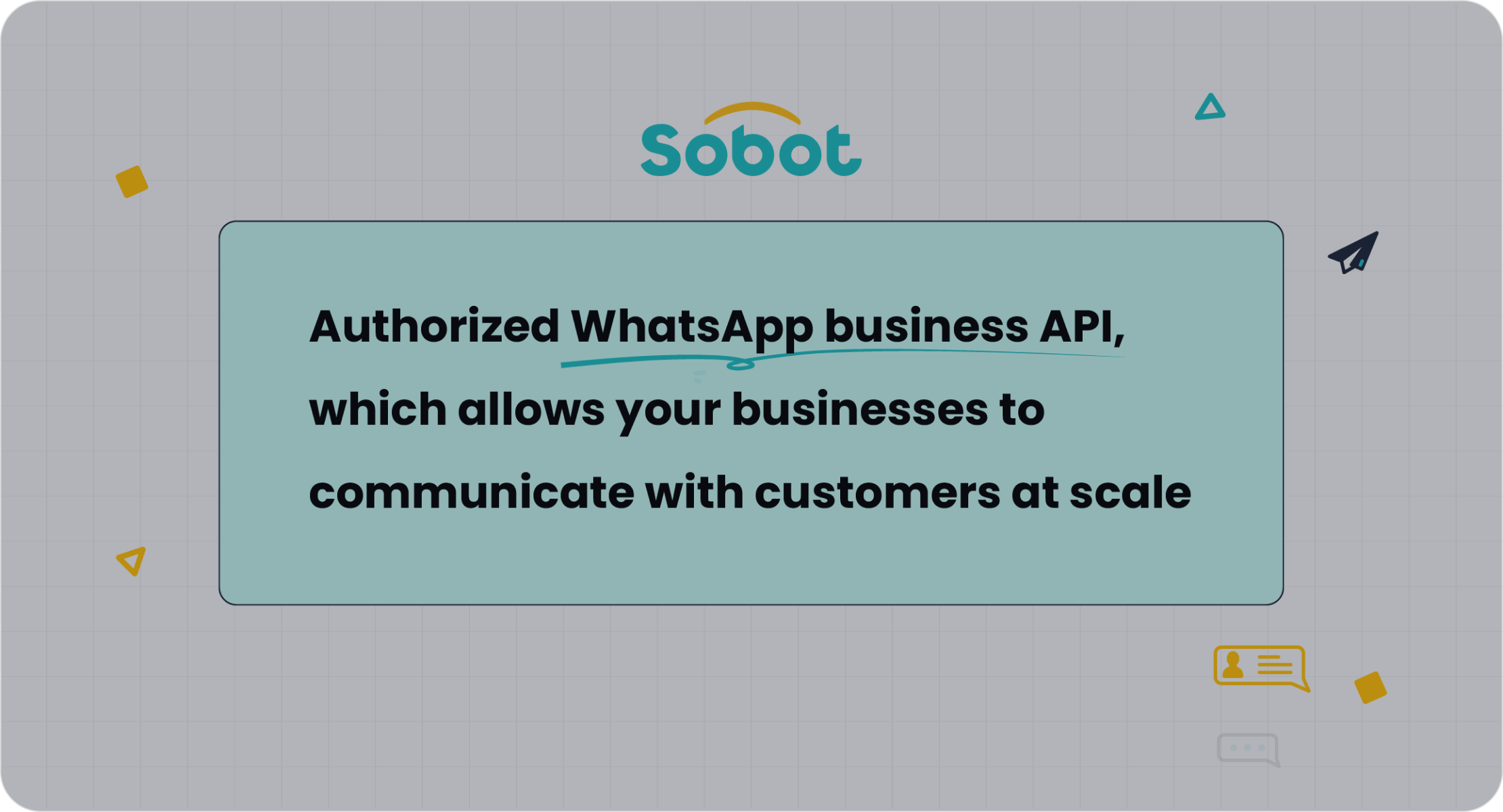
Retailers around the world have seen powerful results by working with omnichannel solution providers. Today, over 90% of global retail businesses use or plan to use omnichannel strategies. Many brands, like those using Sobot AI and the Sobot call center, experience faster response times and improved customer satisfaction. Sobot helps companies connect with customers on channels like WhatsApp, making every interaction seamless. The numbers speak for themselves:
- 87% of retailers see omnichannel as critical for success.
- Only 8% have fully mastered it, showing room for growth.
- More than 80% now offer "Buy Online, Pick Up In Store" features.
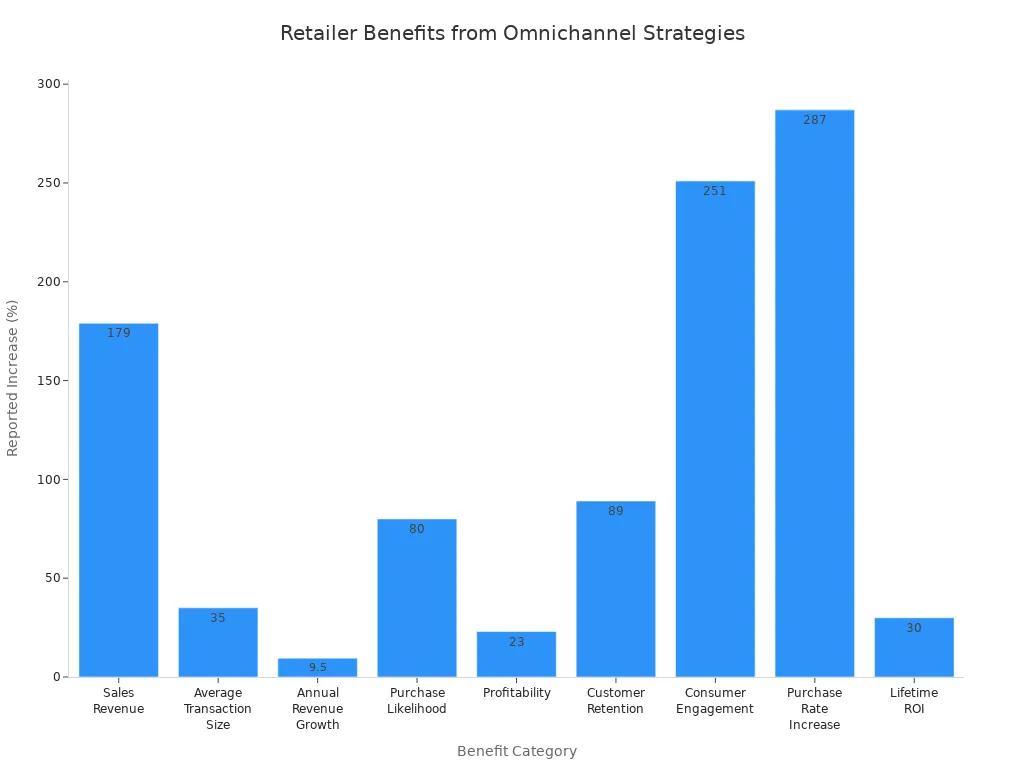
| Benefit Category | Measurable Benefit Reported | Statistic / Percentage |
|---|---|---|
| Sales Revenue | Increase in sales revenue with omnichannel strategies | 179% higher sales revenue compared to non-omnichannel retailers |
| Customer Retention | Average customer retention rate with omnichannel marketing | 89% retention rate |
| Purchase Rate Increase | Increase in purchase rates due to omnichannel marketing | 287% increase |
Sobot empowers brands to achieve these results with its advanced tools and all-in-one platform.
Omnichannel Retail Overview
What Is Omnichannel Retail?
Omnichannel retail brings together every way a customer can shop—online, in-store, or on mobile—into one smooth experience. Leading industry analysts describe omnichannel retail as the integration and cooperation of all channels to create a consistent brand journey. Customers can start shopping on a website, continue on a mobile app, and finish in a physical store without any confusion or lost information. This approach stands apart from multichannel retail, where each channel works alone. In omnichannel retail, all channels connect, so shoppers enjoy a seamless, personalized experience every time.
Omnichannel retail focuses on meeting customers where they are, making shopping easy and enjoyable. Brands like Sobot help retailers unify these touchpoints, ensuring that customer data and conversations flow smoothly across platforms.
Why Omnichannel Matters
Today’s shoppers expect to move between channels without any trouble. Studies show that 73% of customers use multiple channels during their shopping journey. Omnichannel retail meets this need by connecting ecommerce websites, apps, and physical stores. Customers who shop both online and in-store have a 30% higher lifetime value than those who use only one channel. Retailers see higher sales and stronger loyalty when they offer a unified experience. For example, 14% of customers spend more when they can shop across channels, and 86% are willing to pay more for great service. The pandemic made these changes even more important, pushing brands to adapt quickly and focus on customer needs.
- Customers expect to:
- Browse on mobile and pick up in-store.
- Receive real-time updates on orders.
- Enjoy consistent service everywhere.
Sobot’s omnichannel solutions help brands deliver these experiences by integrating ecommerce, chat, and social media into one platform.
Key Features and Standards
A strong omnichannel retail strategy includes several key features:
- Real-time inventory visibility across all channels.
- Flexible returns, such as Buy Online, Return In Store (BORIS).
- Automated customer notifications for every step of the buying journey.
- Unified data from ecommerce, in-store, and mobile platforms.
- Consistent customer experience, no matter where the shopper interacts.
- Secure and flexible payment options, including mobile wallets and Buy Now Pay Later.
- Integration with CRM and marketing tools for personalized offers.
| Feature | Benefit |
|---|---|
| Real-time inventory | Prevents stockouts and surprises |
| Unified customer data | Enables personalized service |
| Flexible fulfillment | Supports BOPIS and easy returns |
| Automated notifications | Keeps customers informed |
Retailers like Michael Kors use Sobot’s omnichannel retail solutions to connect ecommerce, chat, and WhatsApp, creating a seamless journey for every customer. This approach builds loyalty, increases sales, and keeps shoppers coming back.
Leading Omnichannel Solution Providers
Sobot’s Omnichannel Solution
Sobot stands out among omnichannel solution providers by delivering a unified platform that connects every customer touchpoint. The company’s solution brings together channels like WhatsApp, SMS, social media, and live chat, making it easy for brands to manage conversations in one place. Sobot’s WhatsApp integration allows real-time order updates, returns processing, and personalized product recommendations. The platform uses conversational AI and sentiment analysis to create emotion-aware interactions, which helps brands respond quickly and with empathy.
Sobot supports over 50 languages and offers real-time analytics, making it a strong choice for global ecommerce brands. Companies like OPPO and Samsung have seen impressive results. OPPO achieved an 83% chatbot resolution rate and a 57% increase in repurchase rates. Samsung reached a 97% customer satisfaction rate using Sobot’s multilingual and analytics features. Sobot’s platform routes chats by issue type or team, so every customer gets the right help fast. Users praise how Sobot keeps communication organized and ensures every response matches the brand’s values. These strengths make Sobot a leader among omnichannel solution providers for ecommerce.
Sobot’s AI-driven platform empowers brands to deliver seamless, personalized service across all channels, inspiring loyalty and growth.
Other Top Providers
The global market for omnichannel solution providers continues to grow, especially in ecommerce. North America leads with a 36% market share, followed by Europe and Asia-Pacific. Major players include Oracle Corporation, SAP SE, IBM Corporation, Salesforce, NCR Corporation, Diebold Nixdorf, Infosys Limited, Toshiba Corporation, Cognizant Technology Solutions, and Infor Global Solutions. These companies help retailers connect web, mobile, and physical stores, supporting features like real-time inventory, shared carts, and loyalty programs.
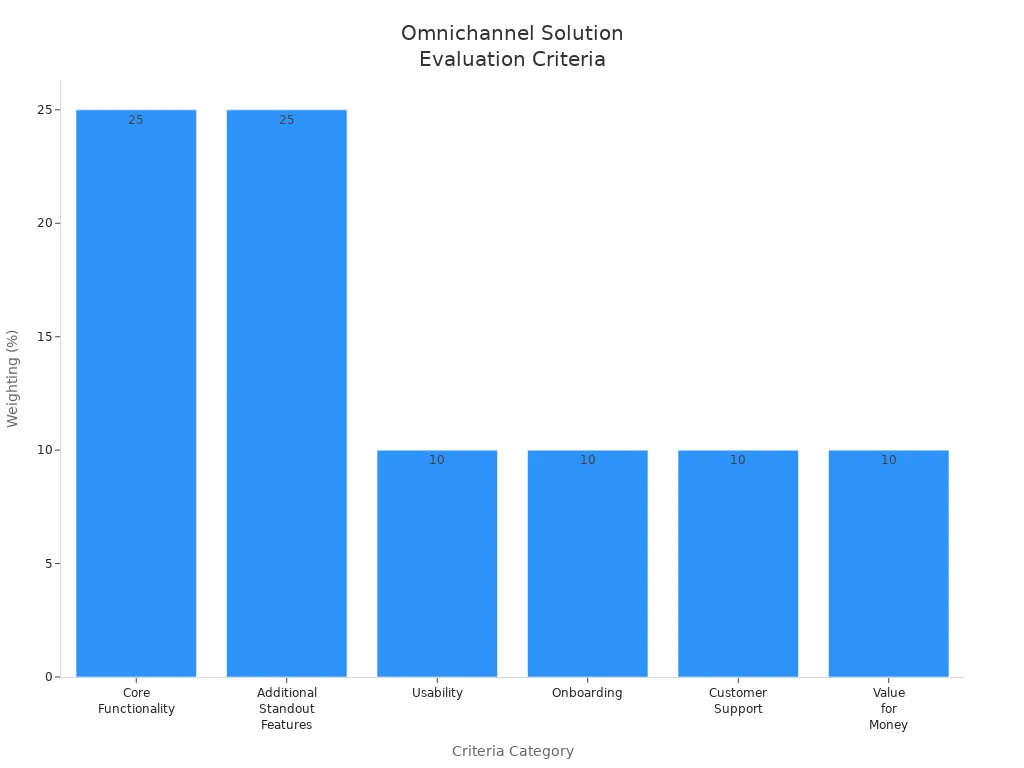
The Omnichannel Retail Index uses over 150 criteria to evaluate these providers, focusing on core functionality, standout features, usability, onboarding, customer support, and value for money. Retailers choose omnichannel solution providers that help them deliver consistent, high-quality experiences across every ecommerce channel.
Omnichannel Marketing Examples
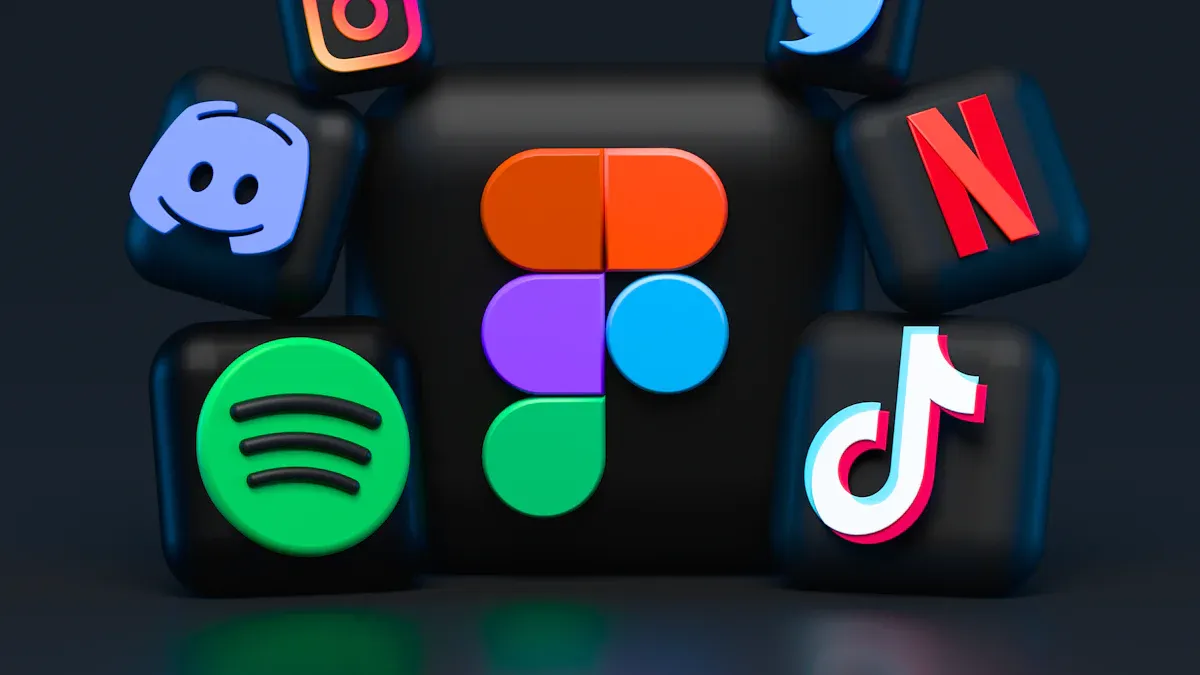
Sobot and Michael Kors
Michael Kors, a global luxury fashion brand, wanted to improve its customer journey and boost engagement. The company faced challenges with slow response times and limited communication channels. Sobot provided an all-in-one omnichannel platform, including its advanced WhatsApp API. This solution unified customer service across chat, phone, and social media, making every interaction smooth and efficient.
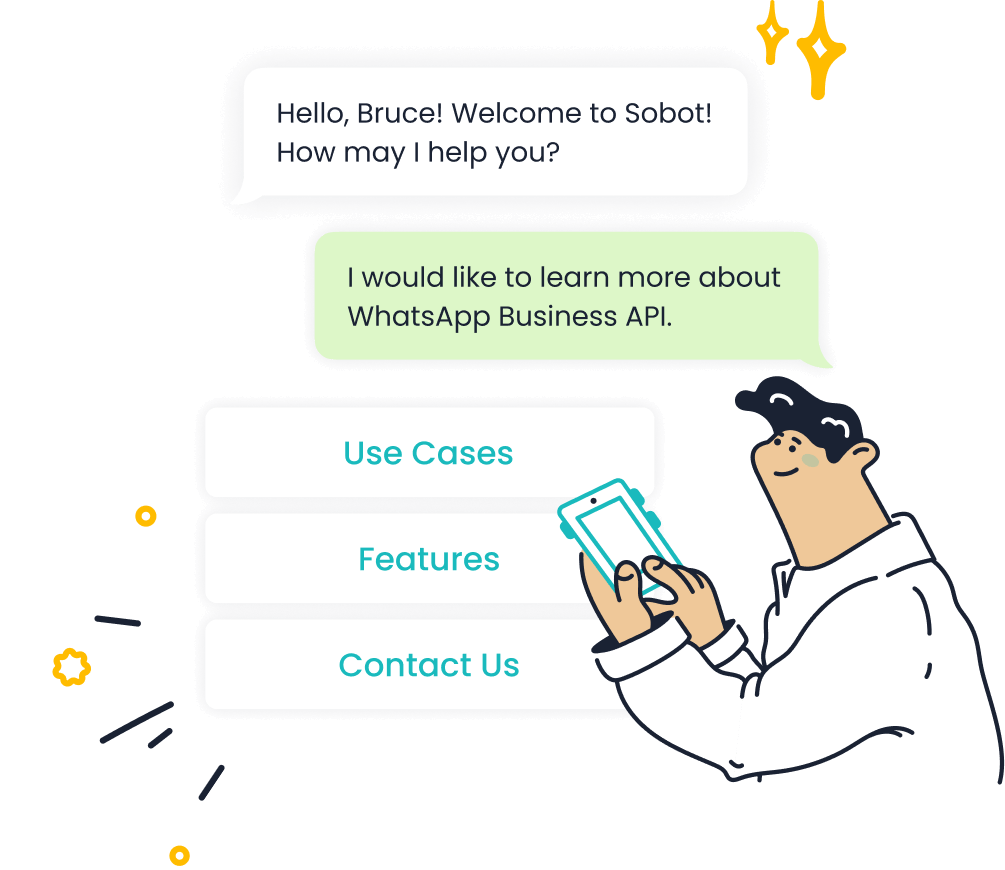
Sobot’s WhatsApp API allowed Michael Kors to send verified bulk messages, automate responses, and offer 24/7 support. Customers received instant replies and personalized experiences, no matter where they started their shopping journey.
Here are the measurable results Michael Kors achieved:
| Metric | Result/Value |
|---|---|
| Customer response rate on Messenger | 97% within one year |
| Chatbot handled FAQs | Over 110 frequently asked questions |
| Automation of repetitive inquiries | Up to 80% |
| Sales conversion rate increase | 15% to 20% |
| Customer service availability | 24/7 support enabled |
| Recognition | “Replies Instantly” badge on Messenger |
Michael Kors saw a 20% increase in conversion rates and a 95% customer satisfaction rate. The key lesson: A unified omnichannel marketing example like this can transform the customer experience and drive loyalty.
Starbucks
Starbucks stands as one of the best real-world examples of omnichannel marketing. The brand wanted to create a seamless customer journey that connects digital and physical experiences. Starbucks used AI and customer data to predict needs, send personalized push notifications, and prepare orders as customers approached stores.
- The Starbucks app accounts for 24% of all U.S. transactions.
- The Starbucks Rewards Program has over 19 million active U.S. members.
- The “Order & Pay” feature increased drive-thru sales by 14% in 2021.
- Personalized marketing boosted average ticket size by 8%.
Starbucks integrates CRM, POS, mobile app, and loyalty programs to deliver a personalized experience. The company’s omnichannel marketing examples show how digital and physical channels can work together to create a frictionless shopping journey. Starbucks achieved a 30% ROI from AI-driven initiatives and a 15% increase in customer engagement. The main takeaway: Consistent, personalized experiences across all channels build strong loyalty and brand value.
Nike
Nike faced the challenge of connecting online and offline shopping journeys. The company used QR codes in stores, mobile apps, and loyalty programs to link every step of the customer journey. Nike’s omnichannel marketing examples include mobile app integration, self-checkout kiosks, and customization zones in stores.
- Nike’s app conversion rate increased by 25%.
- Customer satisfaction scores improved.
- Average order value and online-to-offline conversions rose.
Nike’s real-world examples show how a personalized experience can boost engagement and sales. The brand’s strategy balances direct-to-consumer and wholesale channels, meeting customers wherever they shop. Nike’s approach proves that a seamless, data-driven customer journey leads to higher loyalty and better business results.
These omnichannel marketing examples from Michael Kors, Starbucks, and Nike inspire retailers to create unified, personalized experiences that delight customers at every touchpoint.
Successful Omnichannel Marketing Examples
Disney
Disney sets the gold standard for a seamless customer experience. The company connects every part of the guest journey, from planning a trip to enjoying the parks. Disney’s MyMagic+ system, including MagicBands, links guests to their profiles. This technology lets guests enter parks, unlock hotel rooms, and pay for meals with a simple tap. The My Disney Experience app helps guests plan visits, book tickets, and get real-time updates. Disney also uses social media and digital content to keep fans engaged, even after they leave the parks.
Disney’s approach creates a magical, personalized experience that makes every guest feel special.
Disney’s loyalty program, Disney Movie Insiders, rewards fans for watching movies and engaging online. This program keeps customers coming back. Disney’s focus on customer satisfaction and loyalty has made it the most trusted brand among millennials and Gen Z. In 2022, Disney’s parks and resorts earned nearly $16.5 billion, showing the power of a successful omnichannel marketing strategy.
Zara
Zara has transformed fast fashion with its innovative omnichannel approach. The Store Mode app gives customers a real-time view of inventory in stores and online. Shoppers can scan items in-store to check sizes and colors instantly. Zara’s click-and-collect service lets customers order online and pick up in-store, making shopping easy and flexible.
- Zara’s unified customer support works across all channels.
- Data analytics help Zara offer personalized recommendations.
- Proactive engagement through emails and notifications builds strong customer loyalty.
After launching its omnichannel experience, Zara boosted digital sales by 74%. Companies with strong omnichannel strategies, like Zara, retain about 89% of their customers. Zara’s focus on a seamless customer experience and a strong loyalty program keeps shoppers returning season after season.
Amazon
Amazon leads the way in successful omnichannel marketing examples. The company blends online and offline shopping through Amazon Hub, Whole Foods, and Amazon Go stores. Customers can pick up online orders at physical locations, making shopping more convenient. Amazon’s Prime loyalty program offers free shipping, streaming, and exclusive deals, encouraging repeat purchases.
Amazon uses AI and machine learning to personalize the customer experience. Features like Alexa voice ordering and cashier-less stores make shopping fast and easy. Amazon’s hassle-free returns and proactive customer support boost satisfaction and loyalty. These efforts help Amazon maintain a strong market share and high customer satisfaction scores.
| Brand | Key Omnichannel Features | Impact on Customer Loyalty |
|---|---|---|
| Disney | MagicBands, My Disney Experience | Most trusted brand, high retention |
| Zara | Store Mode, Click-and-Collect | 74% digital sales growth, 89% retention |
| Amazon | Prime, Amazon Hub, AI-driven personalization | High satisfaction, strong market share |
These brands show that a seamless customer experience, a strong loyalty program, and continuous innovation are the keys to building lasting customer loyalty. Retailers can learn from these successful omnichannel marketing examples to inspire their own growth.
Real-Life Case Studies and Lessons
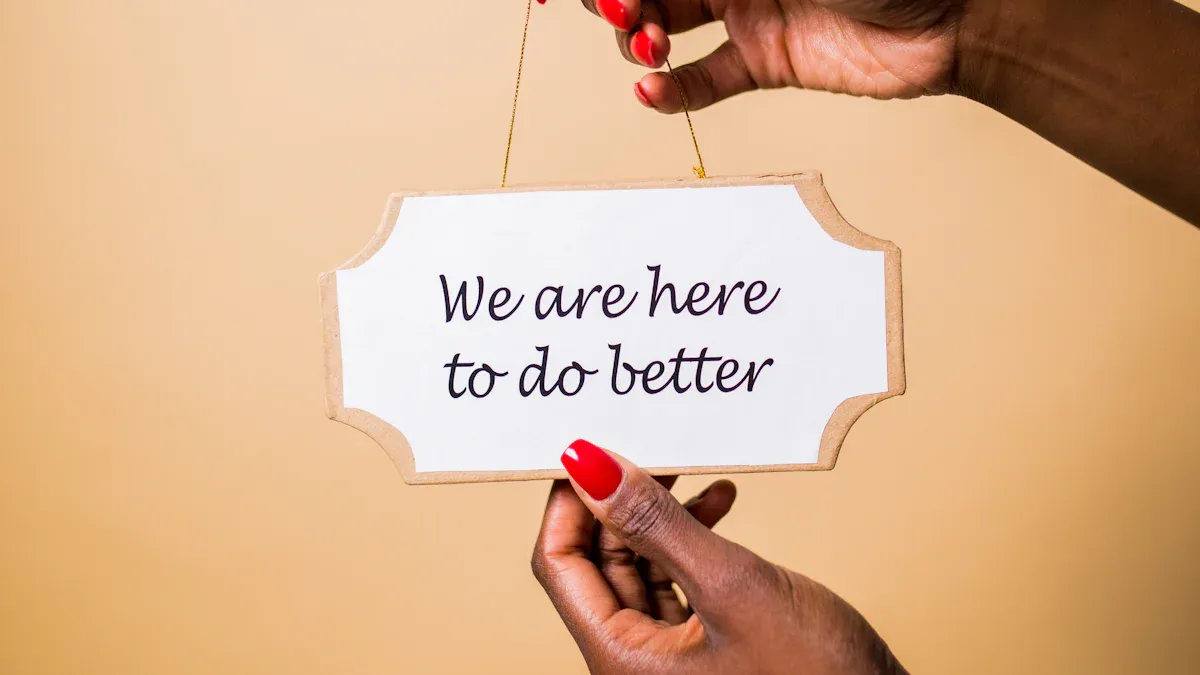
Common Success Factors
Success in omnichannel retail does not happen by chance. Brands that lead the way share several key drivers, as seen in real-life case studies from Michael Kors, Starbucks, Nike, Disney, Zara, and Amazon. These companies focus on delivering an integrated customer experience that delights shoppers at every touchpoint.
- AI-powered personalization stands out as a game changer. Sephora’s Virtual Artist, for example, increased sales by up to 25% and boosted customer engagement by 50%. Sobot’s AI-driven chatbots and WhatsApp integration help brands like Michael Kors achieve a 95% customer satisfaction rate and a 20% increase in conversion rates.
- Enhanced customer engagement strategies, such as 24/7 AI chatbot support, allow brands to resolve up to 90% of inquiries without human intervention. Zara’s chatbot support is a prime example.
- Operational efficiency improves with AI-driven inventory management. Zara reduced stockouts by 30% and overstocking by 25%, saving costs and keeping customers happy.
- Unified customer data platforms and AI journey orchestration create seamless, personalized omnichannel strategies. Leading brands have seen up to a 25% increase in sales and a 30% improvement in customer satisfaction.
- Technology integration remains essential. Real-time inventory visibility, mobile apps, and RFID tagging help brands like Zara and Michael Kors deliver on customer needs and expectations.
- The adoption of emerging technologies, such as augmented reality and predictive analytics, further enhances the customer experience and drives business growth.
Brands that invest in AI, data-driven insights, and unified platforms consistently outperform their peers in customer satisfaction and loyalty.
A growing trend shows that 97% of businesses plan to use AI in customer communications by 2025. Experts predict that half of all customer interactions will be AI-facilitated across channels, making technology a cornerstone of future success.
Actionable Insights
Retailers looking to thrive in the omnichannel era can learn from these real-life case studies. The following actionable insights help brands build a foundation for long-term success:
- Collect comprehensive data and use advanced analytics to guide decisions. Sobot’s omnichannel solution, for example, unifies customer data from chat, phone, and social media, giving brands a 360-degree view of each shopper.
- Break down data silos by integrating legacy systems. Real-time synchronization across channels ensures customers receive consistent service, whether online or in-store.
- Foster a customer-centric culture. Cross-departmental cooperation and staff training help teams deliver a seamless experience.
- Deploy key technologies such as unified advertising platforms, AI-powered optimization engines, and advanced analytics tools. These tools enable brands to personalize marketing and streamline operations.
- Use stores as media, offer BOPIS (Buy Online, Pick Up In Store), and integrate social commerce to create a cohesive journey.
- Personalize every touchpoint. Nordstrom, for example, uses customer data to tailor recommendations and empower sales associates with digital tools.
- Optimize fulfillment with cross-channel strategies like ship-from-store and curbside pickup. These options increase convenience and speed for customers.
- Align the organization through cross-functional teams and executive sponsorship. Training and upskilling help overcome resistance and close skills gaps.
- Adopt foundational technologies, including cloud platforms, AI, mobile apps, IoT, and unified commerce platforms. Sobot’s platform, for instance, integrates with CRM and order systems, automates workflows, and provides real-time analytics for continuous improvement.
Tip: Start with a phased roadmap—assess your current state, set a clear vision, integrate technology, enhance the customer experience, optimize fulfillment, train staff, and run pilots to test new ideas.
Retailers like Target, Walmart, and Nordstrom have demonstrated the power of these insights. Their focus on fulfillment, scale, and personalization has set new standards for the industry.
Choosing the Right Provider
Selecting the best omnichannel solution provider shapes the future of your retail business. The right partner helps you deliver an integrated customer experience, drive customer satisfaction, and support business growth. Here is a step-by-step guide to making the right choice:
- Research software options for suitability, deployment model, and cost.
- Set clear priorities by defining your challenges and must-have features.
- Shortlist vendors that match your business scale, requirements, and budget.
- Share project details and expectations with potential vendors.
- Evaluate software demos using real-life scenarios and scorecards.
- Grade each solution on ease of use, features, and vendor responsiveness.
- Compare quotations and pricing models to ensure value for money.
- Check supplier capacity, experience, financial stability, and request references.
| Criteria | What to Look For |
|---|---|
| Multi-channel data aggregation | Unified view of sales and customer interactions |
| Product synchronization | Accurate, real-time inventory management |
| Loyalty program integration | Seamless rewards and retention features |
| Operational compatibility | Easy integration with existing systems |
| Flexibility and scalability | Ability to adapt as your business grows |
Retailers should also define a clear omnichannel vision aligned with customer needs and future growth. Assess internal readiness, including technology and cross-functional alignment. Shortlist providers based on technology capabilities, such as distributed order management and integration with ERP and ecommerce platforms. Conduct detailed vendor demonstrations and evaluate expertise in the retail industry to reduce customization and speed up implementation. Understand the total cost of ownership, including licensing, support, and additional fees.
Note: Look for solutions that require minimal development, offer sophisticated order routing, and provide real-world demonstrations of flexibility. Future-proof capabilities ensure your business can adapt to changing market conditions.
Sobot stands out as a trusted partner for retailers seeking a comprehensive omnichannel solution. Its platform offers AI-powered chatbots, WhatsApp Business API, unified workspaces, and seamless integration with CRM and order systems. Sobot’s commitment to innovation, customer-centricity, and operational efficiency helps brands achieve high customer satisfaction and loyalty.
Real-life case studies show that the right provider empowers retailers to deliver seamless, personalized experiences, build customer loyalty, and unlock sustainable business growth.
Retailers who lead in omnichannel retail share important habits. They connect online and offline channels, use data analytics for smart decisions, and offer flexible ways for customers to shop. Brands like Starbucks and Zara show that real-time inventory and personalized service build loyalty. Sobot’s omnichannel solution helps retailers unify customer touchpoints and boost satisfaction. Retailers can start by mapping customer journeys, integrating systems, and focusing on innovation. Exploring Sobot’s offerings or booking a demo can inspire the next step toward retail success.
FAQ
What is an omnichannel solution provider?
An omnichannel solution provider helps brands connect with customers across many channels. These channels include chat, phone, email, and social media. Sobot, for example, unifies these touchpoints. This approach creates a seamless journey and boosts customer satisfaction. Many retailers now rely on such providers for growth.
How do omnichannel marketing examples inspire retailers?
Omnichannel marketing examples show real success. Brands like Michael Kors used Sobot’s platform to cut response times by 83%. These stories prove that unified customer experiences lead to higher sales and loyalty. Retailers can learn and apply these lessons to their own strategies.
Why does WhatsApp integration matter in omnichannel retail?
WhatsApp integration lets brands reach customers where they spend time. Sobot’s WhatsApp API supports bulk messaging, 24/7 chatbot support, and smart routing. Michael Kors saw a 20% increase in conversion rates after using this feature. This tool helps brands connect and engage with ease.
What results can retailers expect from using an omnichannel solution provider?
Retailers using omnichannel solution providers often see higher sales, better retention, and improved customer satisfaction. For example, omnichannel strategies can boost sales revenue by 179% and retention rates by 89% (source). Sobot’s clients report faster responses and more loyal customers.
How can a retailer choose the right omnichannel solution provider?
Retailers should look for providers with unified platforms, strong analytics, and easy integration. Sobot offers AI-driven chatbots, WhatsApp Business API, and seamless CRM connections. Brands should review real omnichannel marketing examples and success stories to find a provider that matches their needs.
See Also
Comprehensive Overview Of Omnichannel Call Center Platforms
Authentic Customer Experiences Using Shopify Live Chat
Step-By-Step Process For Deploying Omnichannel Contact Centers
